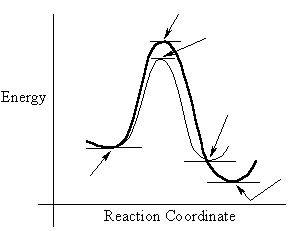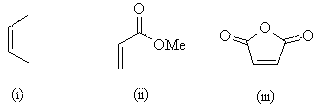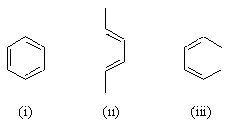| Chapter 10 : Conjugation in Alkadienes and Allylic Systems |
| Chapter 10 : Conjugation in Alkadienes and Allylic Systems |
Conjugation in Alkadienes and Allylic Systems Questions
| Qu 1 | The Diels-Alder reaction of furan and cyclopentadiene at 20oC yields product 1, as shown below. |
| Heating a solution of 1 to 80oC for
1 hour gives a mixture containing a second product 2 (a stereoisomer
of 1) in a ratio of 9:1 (2:1). The reaction of cyclopentadiene and furan at 80oC gives the same 9:1 mixture of 2:1.
|
|
| (a) Which species is the diene and the dienophile in this Diels-Alder reaction ? | |
| (b) Which of the products is endo and which of the products is exo ? | |
| (c) The sole formation of 1 (and not 2) at 20oC is an example of a reaction under which type of control ? | |
| (d) At 80oC, the formation of a 9:1 mixture of 2:1, starting from cyclopentadiene and furan, is an example of a reaction under which type of control ? | |
| (e) Is the formation of 90% 2 from 1 (at 80oC) likely to be a direct isomerization of 1 into 2 ? | |
| (f) As previously stated, when 1
was heated to 80oC for 1 hour, 90% of the material was converted into
2. Heating for a further 10 hours at 80oC produced no further change. Why can we not convert the remaining 10% of 1 into 2 ? |
|
| (g) The bimolecular reaction of cyclopentadiene and furan at 20oC to produce 1 is an exothermic reaction. According to the �Hammond postulate� what does this imply about the transition-state for this reaction ? | |
(h)  Reaction coordinate diagrams are often used to illustrate the energy changes taking place during chemical reactions. Indentify the chemical species that corresponds to each of the points indicated by arrows in the diagram shown to the left. |
|
| Qu 2: | What are the product(s) of the following reactions ? |

|
|

|
|
| Qu 3: | What starting materials are required to produce the product shown ? |

|
|
| Qu 4: | Draw in all of the curly arrows to complete the mechanism for the following reaction scheme: |

|
|
| Qu 5: | (a) Rank the relative reactivity towards 1,3-cyclopentadiene of the following : |

|
|
| (b) Rate the relative reactivity towards dimethyl cis-butendioate of the following: | |

|
|
| (c) Rate the order of the relative reactivity towards 1-buten-3-one of the following: | |

|
| © Dr. Ian Hunt, Department of Chemistry |